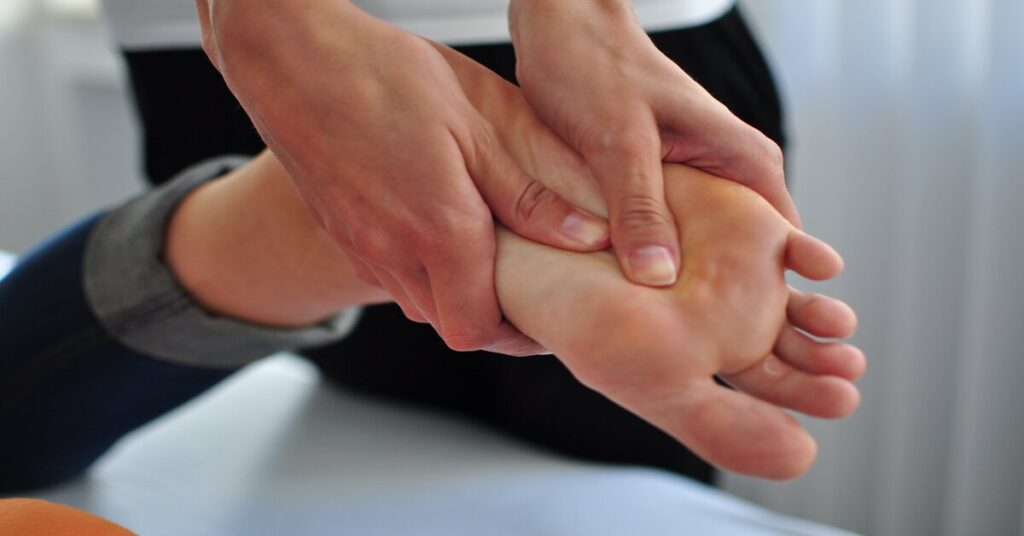
Peripheral neuropathy affects millions of people worldwide, causing discomfort and hindering daily activities. While medication and therapy are common treatments, targeted exercises can also play a crucial role in managing symptoms.
Discover how incorporating these effective exercises into your daily routine can help relieve peripheral neuropathy pain and enhance your overall well-being.
This comprehensive peripheral neuropathy exercises blog post explains peripheral neuropathy, highlights the multifaceted benefits of exercises, and offers actionable tips for developing a safe, personalized exercise routine.
Additionally, it shares inspiring training videos and real-life stories of those suffering from neuropathy who have found relief through exercise. By the end, readers will understand how to incorporate workouts into their lifestyle to alleviate peripheral neuropathy symptoms.
Here is the next section on understanding peripheral neuropathy:
Understanding Peripheral Neuropathy
Peripheral neuropathy refers to damage to the peripheral nervous system, which transmits signals between the central nervous system (the brain and spinal cord) and the rest of the body.
It can result from traumatic injuries, infections, metabolic problems like diabetes, autoimmune diseases, exposure to toxins, chronic alcoholism, and nutrient deficiencies.
Individuals with peripheral neuropathy commonly experience prickling, tingling sensations, numbness, and burning pain in the hands, feet, arms, or legs.
These unpleasant sensations can range from mild to excruciating depending on the severity of nerve damage. In some cases, the pain disrupts sleep and impairs basic functions like walking or standing.
As peripheral nerves become damaged, they are unable to relay signals effectively between the limbs and spine. This communication breakdown leads to weakness, loss of balance and coordination, muscle wasting (atrophy), paralysis, and decreased functioning of bodily organs.
Without treatment, the symptoms can worsen over time and significantly reduce patient mobility and independence.
Here is the next section on the benefits of exercises for peripheral neuropathy:
Benefits of Exercises for Peripheral Neuropathy

Exercise offers multiple benefits that can help relieve peripheral neuropathy symptoms. It stimulates circulation which enhances blood flow, delivering more oxygen and nutrients to nourish damaged peripheral nerves and nerve endings.
Improved circulation can reduce inflammation, swelling, tingling, numbness, and pain associated with neuropathy.
Additionally, as muscles surrounding peripheral nerves grow stronger with targeted strength training, they provide more support and stability to the nerves. This helps prevent compression or additional injury to the fragile nerves. Exercise also releases pain-relieving endorphins which have an analgesic effect.
By gradually building muscle tone, stamina, and endurance through moderate physical activity, individuals with neuropathy can complete everyday tasks more easily.
Their risk of falls decreases as balance improves with exercises. All these factors significantly improve quality of life. Scientifically-validated research confirms that a regular, supervised exercise program leads to meaningful symptom relief and functional improvements for peripheral neuropathy patients.

Seated Exercises To Help With Peripheral Neuropathy
Those with balance issues or mobility limitations may benefit from seated workouts to improve strength, flexibility, and cardiovascular health.
- The seated leg raises tone quadriceps and hip flexors to support nerves in the lower limbs. Holding the lift engages the core too.
- Shoulder and biceps curls with resistance bands build upper body strength required for climbing stairs, walking aids, etc.
- Rotational twists mobilize the spine gently while stretching the abdominals and lower back.
- Ankle pumps and circles boost circulation in the lower extremities, reducing swelling and nerve irritation.
Ease Peripheral Neuropathy Symptoms In Feet and Legs | Peripheral Neuropathy Exercise Routine: Watch Video Below
Stretches To Help With Peripheral Neuropathy
Including stretches prevents next-day muscle soreness allowing consistent exercise adherence. They also enhance circulation and nerve gliding.
- Calf and hamstring stretches alleviate spasms from nerve hyper-excitability.
- Chest and wrist stretches alleviate compression neuropathies like carpal tunnel syndrome.
- The gentle back and hip flexor stretch relaxes tense, overworked postural muscles.
Ease Peripheral Neuropathy Symptoms In Feet and Legs | Peripheral Neuropathy Exercise Routine: Watch Video Below
Standing Exercises To Help With Peripheral Neuropathy: Watch Video Below
Once basic leg strength returns, standing exercises to improve balance and posture are useful, but require supervision initially to prevent falls.
- Heel-toe raises strengthen lower leg and foot intrinsic muscles for improved gait and stability.
- Mini squats and bridges engage the glutes and core muscles for better equilibrium.
- One-leg stands to boost proprioception for everyday tasks like climbing stairs or walking on uneven terrain.
Ease Peripheral Neuropathy Symptoms In Feet and Legs | Peripheral Neuropathy Exercise Routine
Desensitization/Self-Massage
Massaging areas of skin hypersensitivity may help re-train tactile perceptions for reduced irritation from touch stimuli.
- Using textured items like spiky massage balls or vibrating face cleansing brushes makes nerve endings familiarize themselves with new sensations in a controlled manner.
- Alternating hot and cold compresses (cryotherapy) can ‘reboot’ overactive pain-signaling peripheral nerve fibers.
Ease Peripheral Neuropathy Symptoms In Feet and Legs | Peripheral Neuropathy Exercise Routine
Relaxation – Peripheral Neuropathy Exercises
Mastering relaxation skills helps override the neuro-inflammatory stress cycle making pain perception worse.
- Daily diaphragmatic breathing triggers the natural relaxation response lowering heart rate and blood pressure.
- Yoga Nidra guides tense muscle groups to systematically relax from head to toe by focusing inward.
Ease Peripheral Neuropathy Symptoms In Feet and Legs | Peripheral Neuropathy Exercise Routine
Here is the next section on types of exercises for peripheral neuropathy:
Types of Exercises for Peripheral Neuropathy
Certain types of low-impact exercises are recommended for peripheral neuropathy patients as they are unlikely to overtax damaged nerves. It’s best to start slowly and increase duration/intensity gradually under expert guidance.
Aerobic Exercises
Low-intensity aerobic workouts that raise the heart rate adequately without straining weakened nerves and muscles are great for managing neuropathy.
- Walking, cycling or swimming at a comfortable pace help improve cardiovascular health while building leg strength and stamina. Water workouts are especially suitable as water provides cushioning and support.
- Chair aerobics routines allow arm, shoulder and leg movements without bearing full body weight on numbed feet. These can be performed seated even by those with mobility issues.
Strengthening Exercises
Targeted strength training to increase muscle support around peripheral nerves helps stabilize them while reducing painful symptoms.
- Resistance band workouts with varying levels of resistance tone up arm, leg, and core muscles without taxing the joints or nerves excessively.
- Bodyweight squats, bridges, calf raises, and heel drops strengthen the lower body and improve balance when performed carefully.
Flexibility and Balance Exercises
Gentle stretching, yoga, Tai Chi, Qi Gong incorporate controlled movements that enhance flexibility, balance, posture and mind-body awareness. While holding poses, deep breathing transports oxygenated blood to damaged peripheral nerve fibers promoting their repair.
Here is the next section on the recommended peripheral neuropathy exercises regimen:
The Best Low-Impact Exercises for Peripheral Neuropathy
Peripheral neuropathy exercises play an important role in managing neuropathy symptoms. Learn how low-impact exercises can help those suffering from peripheral neuropathy:
Recommended Exercise Regimen
When starting an exercise program, peripheral neuropathy patients must build up duration and intensity gradually over weeks/months to avoid overexertion injuries. A tailored regimen should target improving flexibility, strength, balance, coordination, and cardiovascular fitness.
Initially, short 5-10 minute sessions once or twice a day help acclimatize the body without aggravating symptoms. Aerobic activity should raise the heart rate modestly to 50-70% of the maximum heart rate range for one’s age without crossing the pain threshold.
As stamina improves, gradually increase duration to 20-30 minutes per session, 4-5 days a week.
Strengthening routines should focus on major muscle groups surrounding damaged nerves – calves, thighs, core, shoulders, etc. Use progressively heavier resistance bands or weights over time.
Balance exercises like Tai Chi are best practiced for 30 minutes daily to hone equilibrium and prevent falls. Stretching gently after workouts prevents next-day soreness.
An occupational therapist can devise a safe, sustainable program meeting specific functional needs. Keeping a Peripheral neuropathy exercises log helps observe patterns and progress. Staying motivated with an exercise partner provides social support.
Here is the next section on tips for incorporating exercises safely:

Tips for Incorporating Exercises Safely
Those with peripheral neuropathy need to take ample precautions before and while exercising to prevent falls or injuries.
It’s vital to consult a doctor/physical therapist to understand personal limitations and receive guidance on suitable activities before initiating any new fitness routine. They can suggest appropriate footwear, and assistive devices if required and show modifications for various moves.
Wearing well-cushioned walking shoes or rigid soles provides stability while bearing body weight during standing exercises. Other supportive gear like knee braces, ankle guards, and gripper socks provide extra protection.
Pay close attention to warning signs from your nerves – stop immediately if you experience increasing pain, numbness, or loss of balance while exercising. Take short breaks as needed. Listen to your body and avoid overexertion at all costs. Stay hydrated before, during, and after exercise sessions.
Have a chair, support bar, or wall nearby for stability when attempting balance poses. Exercise at your own pace without comparing yourself to anyone else even if you feel it’s too slow. Consistency with easy routines brings better long-term gains than straining yourself unrealistically.
Here is the next section on real-life success stories or testimonials:
Real-life Success Stories or Testimonials
Incorporating regular Peripheral neuropathy exercises helps many people suffering from peripheral neuropathy manage their symptoms and reclaim functional independence.
John, 48 years old, struggled with worsening neuropathy pain and imbalance after intensive chemotherapy for leukemia. His doctors suggested supervised physiotherapy.
Though skeptical initially, he began aqua aerobics thrice a week. “It has worked wonders for me”, says John. “After just 8 weeks, I have less pain and tingling. My walking has improved remarkably and I don’t need a cane outdoors anymore.”
63-year-old Anna was finding it hard to cope with household chores as her peripheral neuropathy from long-term diabetes caused severe fatigue and muscle loss.
On her son’s insistence, she joined a chair yoga class. 6 months later, Anna shares, “My balance is definitely better now, and my legs feel stronger. I can clean, cook, and pursue my hobbies like gardening again which seemed impossible earlier.”
Such real-world testimonials validate the profound impact simple, regular exercises incorporating aerobic activity, muscle strengthening, and balance training can have in reducing peripheral neuropathy disability and improving quality of life.
Here is the next section on additional lifestyle modifications for neuropathy management:
Additional Lifestyle Modifications for Neuropathy Management
While Peripheral neuropathy exercises provide multifaceted relief benefits, modifying other lifestyle factors holistically improves neuropathy outcomes.
Dietary Changes
Eating a balanced, nutritious diet ensures optimal nerve health. Foods rich in B vitamins like whole grains, seeds, eggs, chicken, fish and leafy greens help repair damaged myelin nerve sheaths when eaten regularly.
Complex carbs provide sustained energy without spiking blood sugar levels. Antioxidants in colorful fruits and veggies quench free radical damage. Hydration is vital for circulation so drink adequate water and herbal teas.
Stress Management
Chronic stress worsens inflammation and neuropathic pain. Relaxation techniques like meditation, yoga nidra, deep breathing, or biofeedback soothe frayed nerves.
Massage therapy provides pain relief while recreational activities foster positive emotions. Prioritizing restful sleep prevents emotional, mental, and physical exhaustion.
These self-care tools reduce anxiety, elevate mood, and help cope with peripheral neuropathy when combined with regular workouts.
Here is the conclusion section:
Ease Peripheral Neuropathy Symptoms In Feet and Legs | Peripheral Neuropathy Exercise Routine
Conclusion On Peripheral Neuropathy Exercises
If you’re struggling with the debilitating effects of peripheral neuropathy, you know how important it is to find relief from the constant pain and discomfort.
Exercise is a powerful tool in combating these symptoms. This article will guide you through the most effective exercises specifically designed to alleviate peripheral neuropathy pain and improve nerve function, helping you regain control over your life.
Real-world patient testimonials validate the scientifically proven benefits of customized exercise regimens for peripheral nerve recovery.
Combined with positive lifestyle changes like nutritious eating, stress management, and restful sleep, exercise addresses neuropathy holistically and effectively.
Yet, most patients battling painful neuropathy remain unaware of these simple self-care steps that could dramatically transform their health.
We must empower ourselves with knowledge and proactively seek professional guidance to develop safe exercise routines to meet our unique needs.
With consistency over time, movement can be medicine offering renewed hope for neuropathy healing one step at a time!
Peripheral neuropathy can make life very difficult. This condition damages the peripheral nerves, which are the nerves that connect the central nervous system to the rest of the body.
Peripheral neuropathy often causes pain, numbness, tingling, and muscle weakness. Doing regular exercise can greatly improve these symptoms.
However, it’s important to choose gentle activities that are low-impact and easy on the body. In this blog post, we will discuss some of the best low-impact exercises for people with peripheral neuropathy.
These Peripheral neuropathy exercises can provide many benefits without further stressing the damaged nerves.
Here is the final section on references and resources:
References and Resources
References
1.Peripheral Neuropathy Fact Sheet. National Institute of Neurological Disorders and Stroke. Updated June 2022. Accessed November 2023. https://www.ninds.nih.gov/Disorders/Patient-Caregiver-Education/Fact-Sheets/Peripheral-Neuropathy-Fact-Sheet
2.Exercise for peripheral neuropathy. Mayo Clinic. Accessed November 2023. https://www.mayoclinic.org/diseases-conditions/peripheral-neuropathy/in-depth/peripheral-neuropathy-treatment/art-20047960
3.Gewandter JS, McDermott MP, McKeown A, et al. Exercise Interventions for Chemotherapy-Induced Peripheral Neuropathy: A Multicenter, Blinded, Randomized Controlled Trial. JAMA Neurol. 2021;78(11):1290–1298.
Additional Resources
Foundation for Peripheral Neuropathy: https://www.foundationforpn.org
Neuropathy Commons Patient Community: https://neuropathycommons.org
World Neuropathy Association: https://worldneuropathy.org













